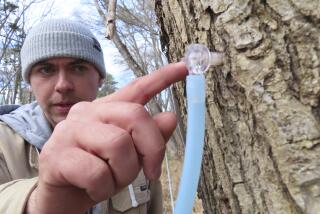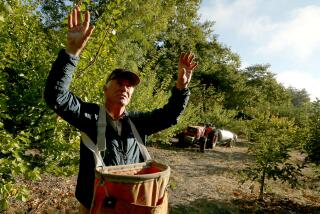The Apples of Monadnock’s Eye
- Share via
JAFFREY, N.H. — Because New Englanders put so much stock in earning their pleasures, the apples they pick themselves always taste better than the store-bought kind.
This isn’t just a trick of the Puritan conscience. Unwaxed, fresh from the tree and popping with juice, Macs especially really are better (and cheaper).
But that’s just the half of it. The real point, as more and more outlanders discover each autumn, is that picking your own apples is a wonderful excuse to get out and enjoy one of the greatest visual feasts this planet has to offer--the incomparably incandescent colors of upper New England’s fall foliage.
Nowhere in the Northeast is it easier to enjoy the best of both these treats than in the orchards of New Hampshire’s Monadnock Mountain Region between late September and mid-October when the apples ripen as the leaves reach their peak of color.
Villages and Mill Towns
Just 60 miles northwest of Boston, this is a 30-by-40-mile area where you still find dairy farms and covered bridges. The stony, reigning summit of Grand Monadnock is visible from some point near each of the region’s 39 steeple-topped villages and rosy brick mill towns.
Stretched out beneath this 3,165-foot height, a chain of lower-lying but brilliantly forested Monadnocks leads east to Lyndeborough. One of them, Rose Mountain, shares its name with a farm established by the son of a Revolutionary War veteran.
Owned by Jan and Jack McEwan, Rose Farm encompasses 45 acres of orchards centering around a maple-shaded white clapboard farmhouse, a big red barn and, typical of the 70-odd pick-your-own apple farms that dot the state, a meadow jampacked with scores of cars, close to half of them from out of state--some from as far away as Florida, California, even Alaska.
As the doors slam shut on these pickup trucks and Cadillacs, Toyotas and Volvos, children who remember their last year’s visit wave “Hi” to the McEwans’ towheaded 8-year-old daughter Jessie, give a couple of quick pats to her two white German shepherds, then run off ahead of their parents to check on the progress of the livestock.
Mini-Zoo in the Barn
Inside the barn, Milly, the sow, and her month-old litter are the stars of the show. In the next stall, the family cat curls up against a dozing goat to nap in a puddle of sunlight. Little hands stretch into the sheep stall to pat the two ewes.
Meanwhile, adults shuffle through the rustling fallen leaves to the Apple Shop. Overhead, the purple-blue sky is brilliant, the wind has the snap of tart cider and the air is crisp as a McIntosh apple.
The leaves of the white birch glow like candle flames, the ash have turned purple, the red oaks appear to have caught fire and the maples, the trees that above all are responsible for New England’s conflagration of color, seem lit from within by every shade of fire from bright orange to vermilion.
Inside the Apple Shop everything needed for a pick-your-own expedition is on hand, including directions to the orchards where the fruit is ripest, plus instructions.
Just Lift and Twist
“If you gently lift and twist the apple, placing your thumb against the stem, it will come off the tree easily,” advises Jack McEwan, a Pan Am pilot as well as an apple farmer. His wife, Jan, is full of friendly chatter and helpful bits of lore. The question she hears most often is what to pick.
“What do you want to use them for?” she asks. For pies or tarts she might recommend the week’s ripe crop of Golden Delicious; for salads, the Cortlands that stay white when cut; for keeping well into winter, a cache of Northern Spy. (Stash them in the refrigerator inside a plastic bag with a few air holes.)
Each of Rose Farm’s 30 varieties has its own best picking time during a harvest season that begins in late August when the green Gravensteins ripen and extends into mid-October when Winesaps are at their prime.
An Abundance of Choices
“Here, try some of these,” Jan says, leading the way to a table where samples of a dozen varieties are arrayed. Crescents of Baldwin, Macoun and Wealthy apples are apt to share the testing table with the more exotically named Vista Bella or the spicy Mutsu and with apples named for their colors: Burgundy, Chenango Strawberry, Winter Banana and the yellow-to-red Opalescent.
Still and all, it’s the McIntosh trees that most people head for. Farmers long ago discovered that something special about the region’s acid soil and high elevation, combined with cool nights and sunny days, bring this variety to perfection.
In the orchards, teen-age helpers distribute bushel boxes (picking half a boxful is the minimum). Last year, Rose Farm’s pick-your-own price of $4.50 for half a bushel was almost a third less than nearby supermarkets were charging.
Rose Farm is largely planted in semi-dwarf trees, making it easy to reach the fruit without ladders or picking poles. Overripe apples are best gathered up for cider. A bushel will yield 2 1/2 gallons of cider, at $2.50 a gallon when squeezed in one of Rose Farm’s three hand-cranked presses. The most popular is the century-old apparatus that sits beside the barn.
Which apples make the best cider? One of Jack McEwan’s favorite formulas is made up of equal parts of McIntosh and Cortland with a few Red Delicious, Baldwin and Monroe tossed in for flavor.
As the trucks, station wagons and occasional limousines, double-decker buses and even antique cars pull out of Rose Farm’s parking field with their sweet-smelling cargoes of fruit, most people notice what a pretty sight the apple trees are, their still-green leaves providing a foil for the red fruit.
As if waiting for their work to be done before putting on their party clothes, apple trees are the last to turn color. Yet when they do, their tawny leaves will warm the chilled, bare, late-October landscape with a festive, orange-pink finale to the season.
-- -- --
Inns of the Monadnock Region:
Prices given are for a couple sharing a double room and bath. They do not include the 7% New Hampshire tax. Meals are available at additional cost. In leaf season especially, reservations are essential. Dinners for two average $25 to $30 in most Monadnock Region inns before wine, tips or the 7% tax. The New Hampshire area code is 603.
Monadnock Inn is known far and wide for its superb food. Rooms, $50. Closed Mondays and, during leaf season, for Saturday lunch. Box B, Jaffrey Center, N.H. 03454, phone 532-7001.
John Hancock Inn boasts 140-year-old murals by itinerant painter Rufus Porter. Rooms $54.40. Open every day for breakfast, lunch and dinner. Hancock, N.H. 03449, phone 525-3318.
The Inn at Crotched Mountain is 150 years old. Rooms, $60 and $70. Open for dinner only every night during leaf season. Mountain Road, Francestown, N.H. 03043, phone 588-6352.
Ram-in-the-Thicket has an indoor pool, Victorian decor. Rooms $55, includes breakfast. No lunch but dinner every evening. Maple Street, Milford, N.H. 03055, phone 654-6440.
The Birchwood Inn, on the National Register of Historic Places, has no private baths but rooms are $41 to $45, including breakfast. Open for breakfast every day except Monday and dinner every day except Sunday and Monday. Bring your own wine. Route 45, Temple, N.H. 03084, phone 878-3285.
Folkway restaurant has a few rooms with shared bath for $40. Open for Sunday brunch plus lunch and dinner every day except Sunday and Monday. 85 Grove St., Peterborough, N.H. 03458, phone 924-7484.
Stepping Stones Bed and Breakfast is on the historic Bennington Battle Trail. No private baths but rooms are $35 including breakfast. Wilton Center, N.H. 03086, phone 654-9048.
Woodbound Inn is a lakeside family resort. Rooms $116 including breakfast and dinner. Three meals a day are served seven days a week. Jaffrey, N.H. 03452, phone 532-8341.
Fitzwilliam Inn is surrounded by antique shops. Rooms $35. Open every day for lunch and dinner. Fitzwilliam, N.H. 03447, phone 585-9000.
For additional accommodations, write to Country Inns and Bed & Breakfasts of the Monadnock Region, P.O. Box 236, Jaffrey, N.H. 03452.
To reach Rose Farm from the Boston area, take the Everett Turnpike (U.S. 3) north to Exit 7W at Nashua, N.H. Follow New Hampshire 101A west. Take the Milford Bypass (N.H. 101) west until it forms a T at the second traffic light. Drive west .2 mile to a green iron bridge. Cross the bridge, turn right and drive one mile to a crossroad. Turn left up the hill, four miles to Rose Farm.
More to Read
Sign up for The Wild
We’ll help you find the best places to hike, bike and run, as well as the perfect silent spots for meditation and yoga.
You may occasionally receive promotional content from the Los Angeles Times.






